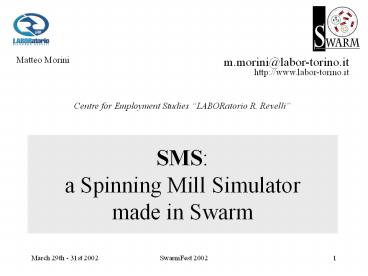SMS: a Spinning Mill Simulator made in Swarm PowerPoint PPT Presentation
Title: SMS: a Spinning Mill Simulator made in Swarm
1
SMSa Spinning Mill Simulatormade in Swarm
- m.morini_at_labor-torino.it
Matteo Morini
http//www.labor-torino.it
Centre for Employment Studies LABORatorio R.
Revelli
2
Production managementthe problem
- Matching orders and production units (PU)
- Appropriate sequencing of each chain
- Who is supposed to do what AND in which sequence?
3
Production Constraints
- Timely delivery
- Soft technical constraints
- Hard technical constraints
4
Solutions evaluation
- Modelling the firms supply chain
- Simulating the production process for each order
- Accounting for
- Set-ups
- Lead times
- Technical similarity of products in a row
- Speed of heterogeneous PUs
5
Search for good production plans
- GA (G. Ferraris Genetic Manipulator)
- Each solution is coded in form of a binary string
- The SCN model can evaluate each plans fitness in
terms of tC (minus total costs)
6
Fitness evaluation (in-depth)
- Delay costs
- Setup costs
- Misplacing order costs
- Average count costs
- Overlaying setups costs
7
Fitness evaluation (in-depth)
- Delay costs
- Setup costs
- Misplacing order costs
- Average count costs
- Overlaying setups costs
8
Fitness evaluation(Delay setup)
Cost
Total cost
Delay cost
Setup cost
Lot size
9
Late deliveries cost
Cost
Delay
10
Set-up costs
Set-up
11
Fitness evaluation (in-depth)
- Delay costs
- Setup costs
- Misplacing order costs
- Average count costs
- Overlaying setups costs
12
Misplaced orders costs
- Different yarns need different bobbins
- Cylinder-shaped, ready for dyeing
- Cone-shaped, ready for weaving
- Extremely urgent deliveries may end being made on
the wrong kind of PU - Re-winding a certain amount of product has a
known cost, epxressed in money/kg.
13
Fitness evaluation (in-depth)
- Delay costs
- Setup costs
- Misplacing order costs
- Average count costs
- Overlaying setups costs
14
Average count costs
Cost
Optimal average count
Preceeding and subsequent departments shortage
Preceeding and subsquent departments saturation
Count
15
Fitness evaluation (in-depth)
- Delay costs
- Setup costs
- Misplacing order costs
- Average count costs
- Overlaying setups costs
16
Overlapping (interfering)setup costs
Cost
simultaneous setups
17
The plannerevolution and working modes
- RANDOM planner (1)
- Explicit rules (failed attempt) (2)
- Optimizing by Genetic Algorithms (3)
- Applying a human-made program (4)
18
Comparing results
- Total costs obtained on test case
- (1) random 100.00
- (3) GA (5 run) 68.75
- (3) GA (30 run) 62.25
- (3) GA (6h run) 60.62
- (4) hand made by human planner 82.27
19
Encoding sequences intobinary strings
8 1 7 2 4 3 5 1 3 2 6 3 2 1 11 2
9 3
- From base10 into base2 (using enough bits)
1000 01 0111 10 0100 11 0101 01 0011 10
0110 11...
- Semantics is lost from the GA perspective
100001011110010011010101001110011011...
20
Solutions evolution graph
21
SMS in action (w/GUI)
22
SMS batch mode sms b
- EC grant (project Penelope)
- Cordis Fifth Framework IST programme
- http//www.cordis.lu/fp5/home.html
- SMS to become part of a bigger framework
- SMS as the engine of a web-based production
planning service
23
SMS is ERA compliant
24
m.morini_at_labor-torino.it
Matteo Morini
http//www.labor-torino.it
Centre for Employment Studies LABORatorio R.
Revelli
SMSa Spinning Mill Simulatormade in Swarm

